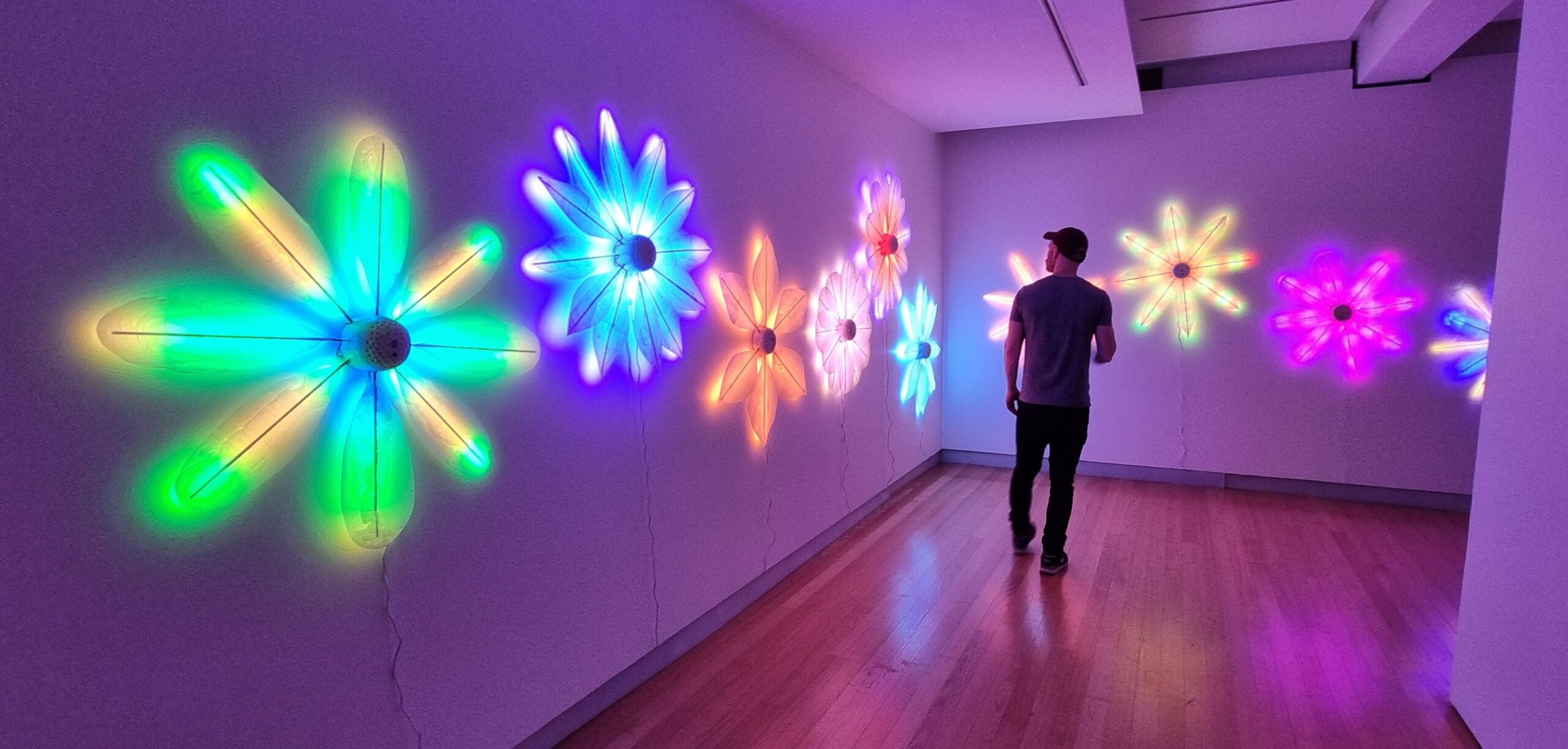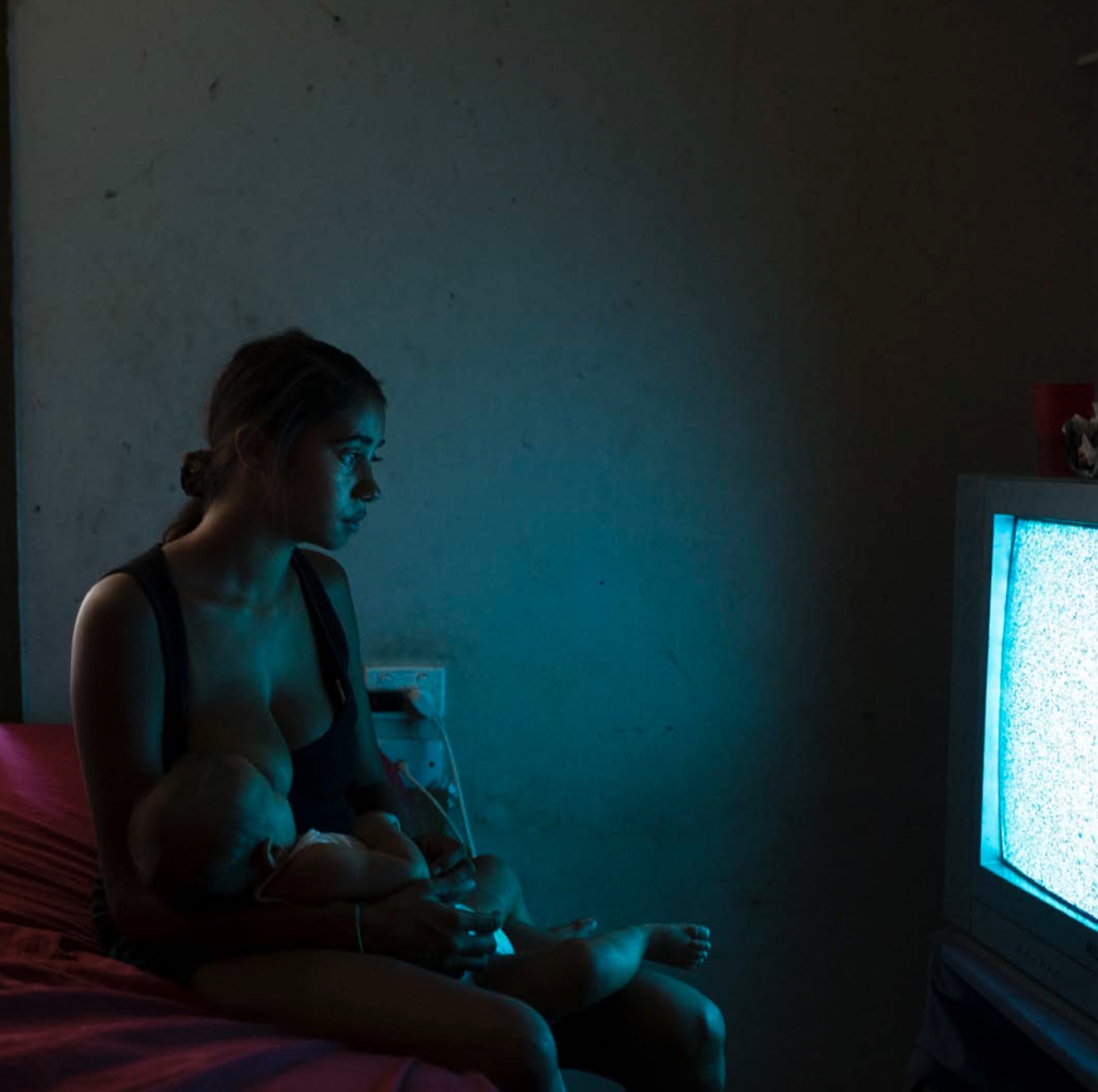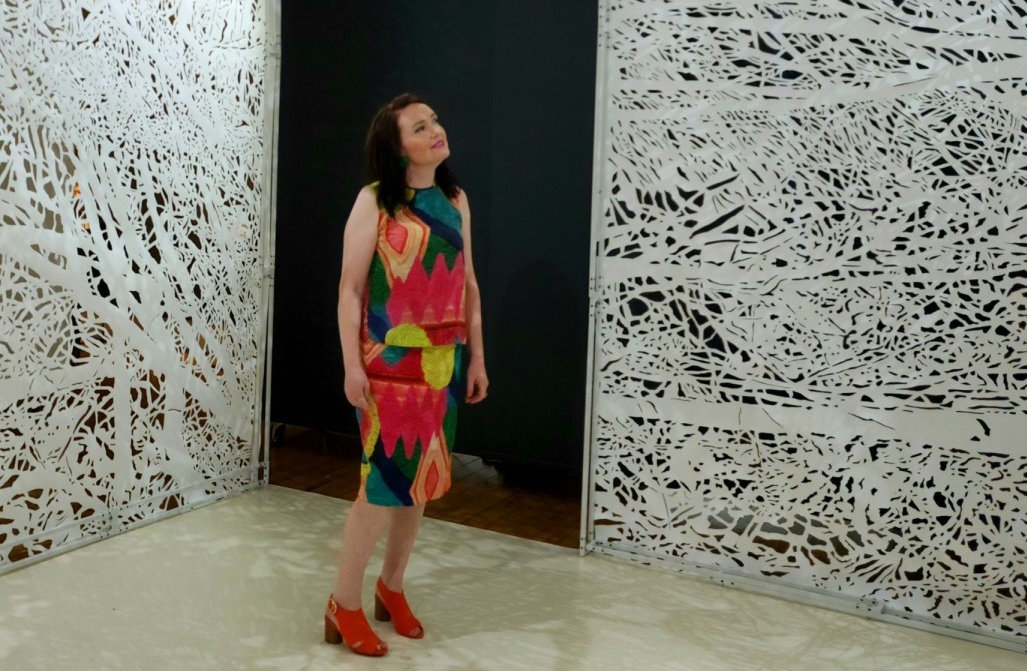FORCED PERSPECTIVE is the latest in Umbrella Studio’s recent push for curated exhibitions, and is an excellent and resolved composite of local and national talent. Much like the recent Postworld exhibition, which is set to tour, FORCED PERSPECTIVE brings together diverse but complementary artists, and revels in the kind of fun and spontaneity that is often lacking in larger institutions. Curated by Daniel Qualischefski, the exhibition is playful and visually tantalising, as one may expect from a curator with an artistic practice. The intimacy of the space is rewarded with a comfortable install, allowing each work to breathe.
Play extends throughout much of the exhibition, imbuing the even more conceptual of cogitative works a sense of joy absent in so much contemporary art. Sarah Ryan’s lenticular presentation lends her photographic works an irreverence and a winking edge distinct from much contemporary photography, ever obsessed with image, surface, and little else. Ryan’s work embraces the curatorial throughline with a process we commonly associate with childhood toys; given the preponderance of lenticular imaging in the 1990s (comic books, trading cards, Tazos, advertising) it is surprising that more artists have not embraced the process, especially given its visual possibilities, and the near-universality of nostalgia in contemporary art. Ryan’s images are far more quiet and restrained than a Bugs Bunny Tazo, but this is just as well, as the form can turn to kitsch just as easily as its shimmering image can change from a different vantage. As the exhibition promises, we just need to consider things from a different vantage.
It is no mistake that, given the premise of the exhibition, a variety of media allows for a certain looseness, enabling ideas and concepts to bounce from work to work. Linda Clark’s Strange Comfort I, which incorporates both video and sculptural elements, works in its relative understatement. Situated near Ryan’s works brings forth an even stronger sense of quietude in this piece. Strange Comfort I is also a meditation on slow art, its own perspectives similarly manipulated with the movement of light. Exploring motherhood and artistic practice with gentle introspection, Clark’s piece invites and excludes the viewer from its intimate context.
Perhaps by dint of their organic appearance, on first viewing Marion Gaemers’ Dancer works are the most difficult to reconcile with the rest of the show, but conversely they are one of the most faithful thematic responses. Much of Gaemers’ recent output has been created collaboratively, so it is good to see the artist once again playing with long term concerns, this time adding the dimension of mechanized movement to her oeuvre. Movement is already implied in the sculptural forms and structures, begging the question as to the necessity of mechanization, but it is playful nonetheless. In a way, the sequential stills of the work included in the concise but sumptuous exhibition publication are more effective than the mechanization.
Uji ‘Hahan’ Eko Sapturo’s bulky and cartoonish resin sculpture, Standing Up In The Market’s Barrels, is somewhat of a show stealer, with its high finish (achieved with auto paint) and cheeky, braggadocio character. The swole, ‘roided up figure is bursting with energy and flatulence, with little gaseous eruptions (complete with frowny faces) erupting from various muscles and armpits. An interesting (if on-the-nose) detail of the work is the sculpture’s base, which is stamped with the logos of various visual arts institutions, including some in which Hahan has himself exhibited. This aligns the work (deliberately or not) with political cartooning and gives it the appearance of an axe or two to grind. This is all well and good, but seeing an artist of Hahan’s calibre (and international CV) mic-dropping amid regional artists who may never be given such exhibition opportunities simply by virtue of distance is a little awkward.
Ann Debono’s included work is an intricately rendered oil painting of a bridge or, more specifically, it is a painting of a photographic collage of a bridge. In a time when photographic painting dominates the commercial art world, subversions and detours are welcome in their critique. What is surprising is this works’ selection; anybody familiar with Debono’s practice may wonder why this particular piece was included, rather than a work that literally collides images and forms together in paint. Surely FORCED PERSPECTIVE was the perfect context for the artist to present their weirdest, most challenging piece? Perhaps the exhibition has offered a chance for the artist to explore other avenues without the pressure of an entire exhibition, or the artist’s own Dada-tinged canon.
Where Gaemers, Ryan, and Clark all simulate animation, Andrew Strauss engages with it directly, using an evolving algorithm that generates, without repetition, matrices of rectangular prisms and the negative space surrounding them. While viewers are encouraged to change the algorithm, or take a digital ‘snapshot’ of a never-to-be-repeated moment in time, I would suggest that, though fun, these additions to the work risk trivialising a perfectly strong, even profound, piece. To wit: Strauss’ work considered solo, without audience-input-buttons, embodies an intimidating marriage of concept, technology, aesthetics, and formalism that freely converses with art of the 20th century right up until the present day.
Stephen Coutts and Peatree round out the exhibition with intricate and highly finished sculptures, each deceptive in their complexity, incorporating hidden forms and imagery available only to the inquisitive. Coutts’ wooden sculptures explore the unconscious via the cosmology established by Freud and Jung, and as such are both revealing and obscurantist. Forms shift and transmute into other forms, leaving one with the impression that this is just a taste of a vast inner world. Peatree’s approach to sculpture is that of a puzzlebox; seamlessly incorporating 3d shapes that form and fit as positive and negative. The urge to play and reconfigure the forms is almost too much to bear, and perhaps should be monitored by an invigilator or put behind glass, should this reviewer return to the gallery.
FORCED PERSPECTIVE is curated by Daniel Qualischefski of Umbrella Studio Contemporary Arts. The North Australian Festival of Arts (NAFA) is a commissioning partner for the exhibition.
Jonathan McBurnie is an artist and writer, and is the Director of Rockhampton Museum of Art. Jonathan lives and works on beautiful Darumbal country.








